How To Make the Kinetic Egyptian Sun Pendant
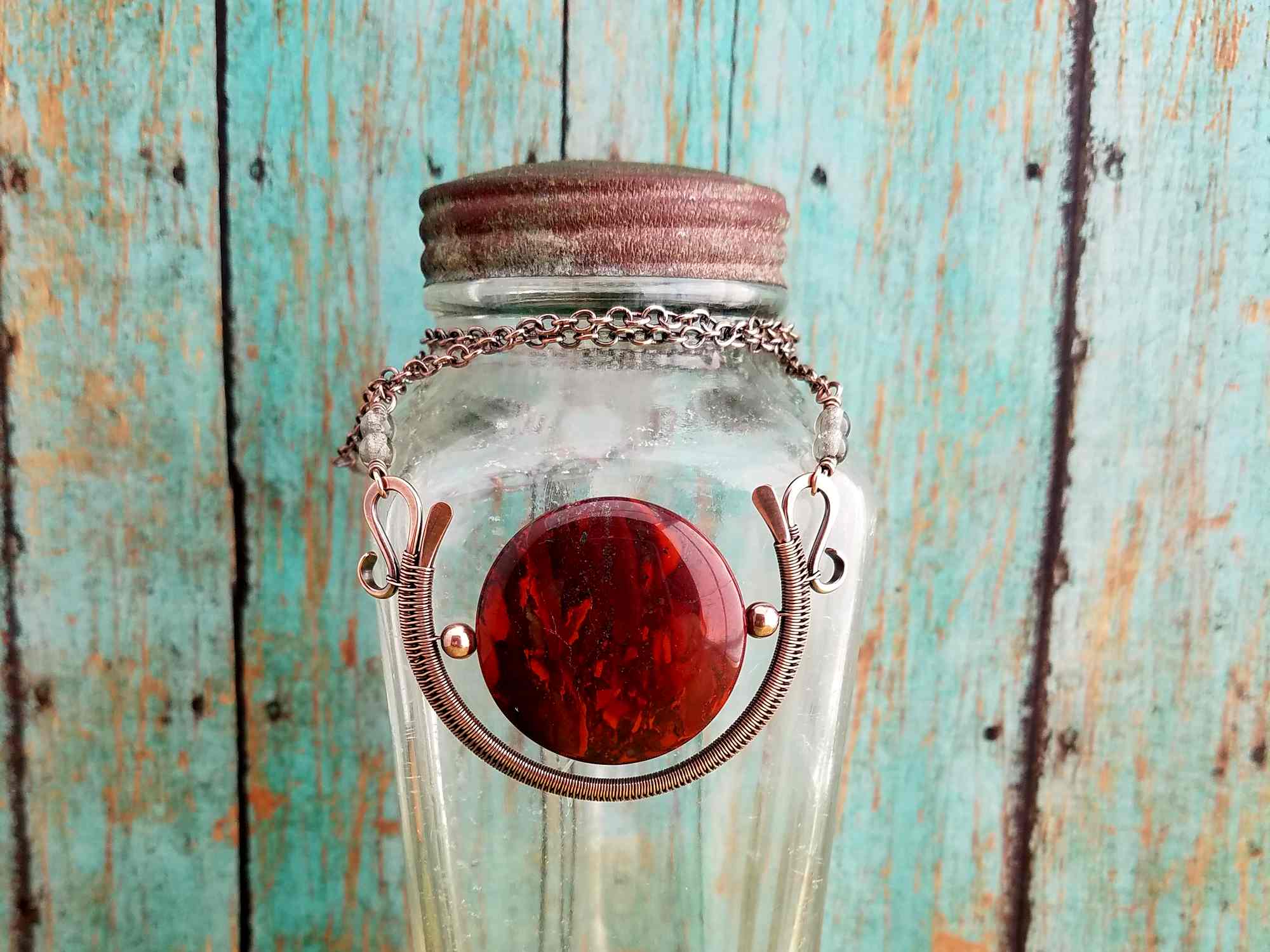
Much like its sister New Moon Pendant, the Egyptian Sun Pendant has a distinctly Egyptian feel with clean simple lines. This is a kinetic piece that allows the wearer to choose which side of the coin to display. I love the versatility of the Egyptian Sun bead frame because I often find it difficult to choose the “front” face of gemstone coin beads. There’s not always a clear winner in terms of movement and interest on one or the other side of a gemstone bead. But this design virtually eliminates the need to choose because the bead spins freely within the frame.
I chose a 30mm center side-drilled Apple Jasper stone for this tutorial. I ordered these pretty red gemstone beads online from Cherry Tree Beads. This is the only bead supplier that I know of that regularly carries center-drilled gemstone coin beads in focal bead sizes. And that fact alone makes them one of my favorite sources for gemstone beads because I love making my Egyptian Sun Pendants.
Copyright & Disclosure
You’re welcome to make and sell products from this tutorial on the condition that you credit Wendi of Door 44 Studios for the design and link back to this page.
When it comes to my written tutorials, however, I reserve exclusive rights to all images and written content. You may not reproduce or redistribute any portion of the Egyptian Sun Pendant tutorial in any way, shape, or form. Furthermore, you may not teach the designs contained within this tutorial without my written permission.
This copyright applies to the printable PDF version of the versatile kinetic Egyptian Sun Pendant tutorial as well, and it’s included therein. You may share the free version of this tutorial only by linking directly to this page.
This post may contain affiliate links. If you click on a link and then make a purchase, I may earn a small commission (at no cost to you). As an Amazon Associate I earn from qualifying purchases. To learn more, please see my full disclaimer.
Getting Started
You may use half-hard or dead soft solid jewelry wire for the core wires for the Etyptian Sun Pendant. Because we’re using heavier gauges, and there’s no heat involved, this design will work just as well with brass or bronze wire as it does with copper or sterling silver.
As usual, you’ll need dead soft wire in the same (or a compatible) alloy for weaving. If you choose sterling silver for your core wires, I recommend using dead soft fine silver for weaving. You’ll also need to modify the way that you suspend your focal bead if you choose silver wire. I’ve included instructions for that modification in this tutorial.
If you choose to use a filled wire, be aware that the bead frames are finished and hardened by hammering the wire. Even light hammering can expose the base metal core in filled wires, which can negatively affect your final finish. As always, I don’t recommend plated or anodized craft wire for this necklace as those coatings will be ruined with this construction process.
How to Choose the Right Jewelry Wire
Jewelry wire is a constant source of confusion for beginners. If you’d like to have a clearer understanding of how to choose the right jewelry wire for wire weaving, be sure to read this post. In it, I share everything you need to know about jewelry wire as you set out on your wire weaving journey.

Tools & Materials
- Dead Soft Wire for the Bead Frame
- 14ga – 3.5 inches (9 cm)
- 16ga – 5.5 inches (14 cm)
- 28g – 8 feet (2.5 m)
- 30mm center side-drilled coin bead – 1 each
- 4mm copper beads – 2 each
- 3mm to 6mm accent beads of your choice – 4+ each (optional)
- 18ga wire – 6 inches (15 cm) for a medium Easy Infinity Clasp (optional)
- 22ga wire – 10 inches (25 cm) for four wrapped loop connectors (optional)
- 24ga wire – 6 inches (15 cm) for the alternate bead suspension method (optional)
- Mediumweight necklace chain to match your wire (optional) – 16 inches (40 cm). Here’s a link to the copper chain that I used while writing this tutorial.
- Wire Cutters
- Chain Nose Pliers
- Stepped Bail-Making Pliers
- Nylon Jaw Pliers
- Needle File
- Nylon Mallet or Rawhide Mallet
- Chasing Hammer
- Bench Block
- 1-1/4-inch mandrel. I use a copper pipe fitting that I picked up at my local Lowe’s store. I’ve linked directly to that item here for your convenience. This tool is optional but helpful for this tutorial as well as many other Door 44 Studios tutorials.
- Ruler
- Fine Point Permanent Marker
- Sharp Beading Awl (optional)
- Sunshine® polishing cloths (optional). These are the polishing cloths that I use for dry polishing jewelry.
Finished Size
- WIDTH: about 2-1/8 inch (5.40 cm)
- LENGTH: about 1-1/2 inches (3.81 cm)
I added a medium-weight 18-inch chain embellished with 4mm Czech glass
You can easily change the length of your necklace by changing the length of the two chain segments. Embellished chains are a great way to express your unique personality and style, so feel free to experiment.
Skill Level: Intermediate
This is a more challenging project that involves wire weaving. It can be achieved by someone who has some basic wirework skills.
This tutorial uses the Modified Soumak Weave for two core wires. Be sure to review that tutorial if you’re not already familiar with this weave. You should also be comfortable weaving pre-formed core wires for this tutorial.
This is a super simple bead frame to make. The trickiest part of the whole process is suspending your focal bead in such a way that the weave is seamless, and the bead appears to float within the frame.
Don’t worry. I’ll walk you through my process for suspending the focal stone but be prepared to break a wire or two as you work through this tutorial for the first time. Suspending your bead properly within the frame can be a challenge, but the results are well worth the effort.
How to Make the Kinetic Egyptian Sun Pendant
These instructions assume that you’re using a 30mm center side-drilled coin bead, as specified in the materials list. However, the Egyptian Sun Pendant can be easily adapted to any center side-drilled bead by simply changing the size of the metal spacer beads and/or the size of the bead frame.
I’ve listed my recommendations for resizing the bead frame to fit smaller or larger coin beads in the Variations section of this tutorial. Refer to that section now if you’ve chosen to use a focal bead that is substantially larger or smaller than the 30mm gemstone bead that I used. Otherwise, proceed with the instructions for the bead frame, as written.
Form the Core Wires for the Egyptian Sun Bead Frame
Step 1
Measure and cut one piece of 14g wire at 3.5 inches.
File the ends smooth, if necessary, and mark the center of your wire with your permanent marker.
This 14g wire is the core wire that lies closest to your focal bead. It provides the foundation for your bead frame and forms the bezel around your focal stone, so you want it to be sturdy. Always choose the heaviest gauge wire that makes sense for your focal bead for this foundational core wire.

Step 2
Measure and cut one piece of 16g wire 5-1/2 inches long.
File the ends smooth, if necessary, and mark the center of your wire with your permanent marker.
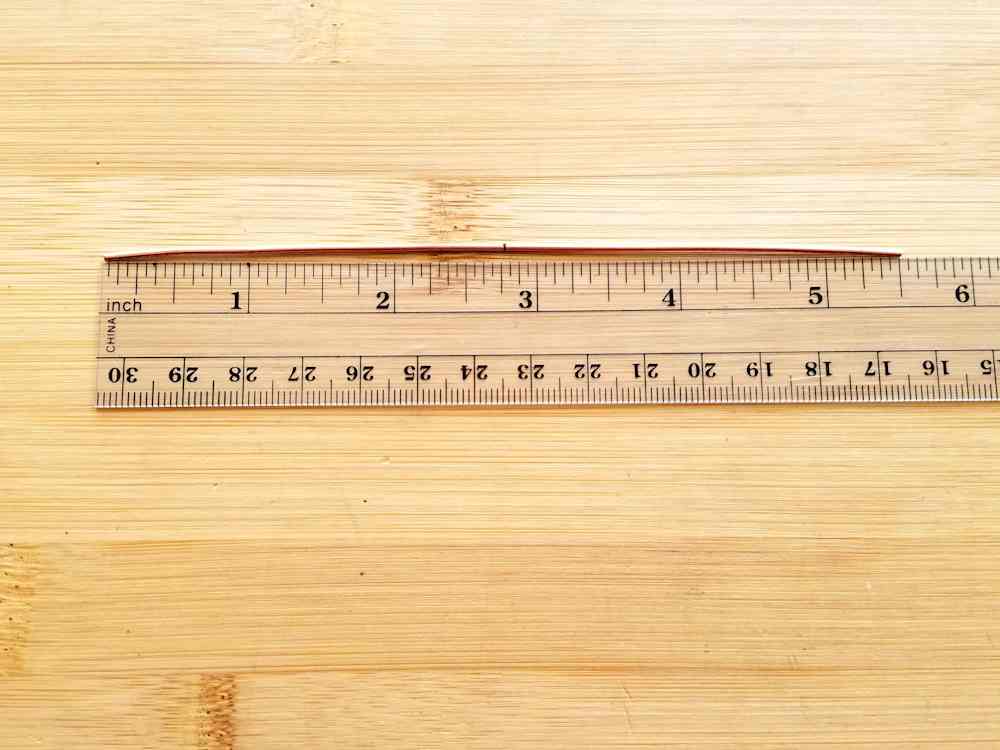
Step 3
Use the 1-1/4-inch mandrel to shape the 3.5-inch 14g wire into a smooth continuous curve. Use your soft mallet to form the ends of the wire around the mandrel. We’ll call this Wire 1.
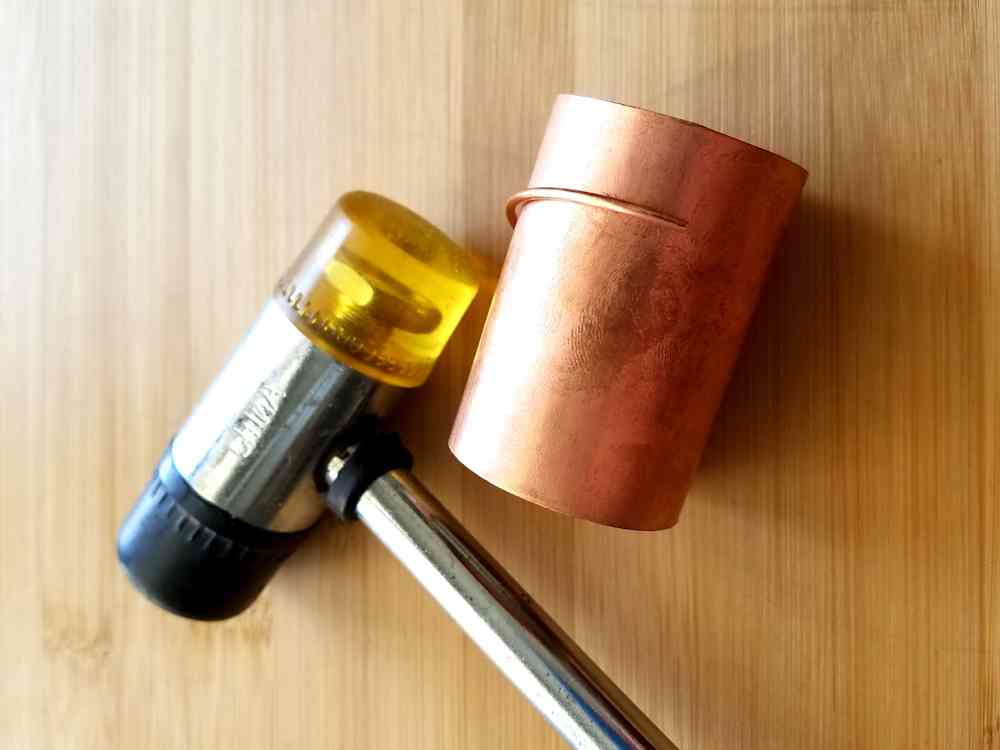
Step 4
Now test the fit of that core wire around your focal bead and two spacer beads. You may need to either stretch or tighten the curve just a bit so that the 14g wire fits comfortably and evenly around your beads.
You want a close fit, but not too snug or you’ll have trouble suspending your bead from the frame later in this tutorial.

Step 5
Use your bench block and chasing hammer to paddle the ends of the curved wire as well as the ends of the remaining 5.5-inch 16g wire (Wire 2). You want just a slight paddle on about 1/4 inch of each end of the wire.
Smooth and shape the paddles with your needle file, if necessary, until your two core wires look like those shown.
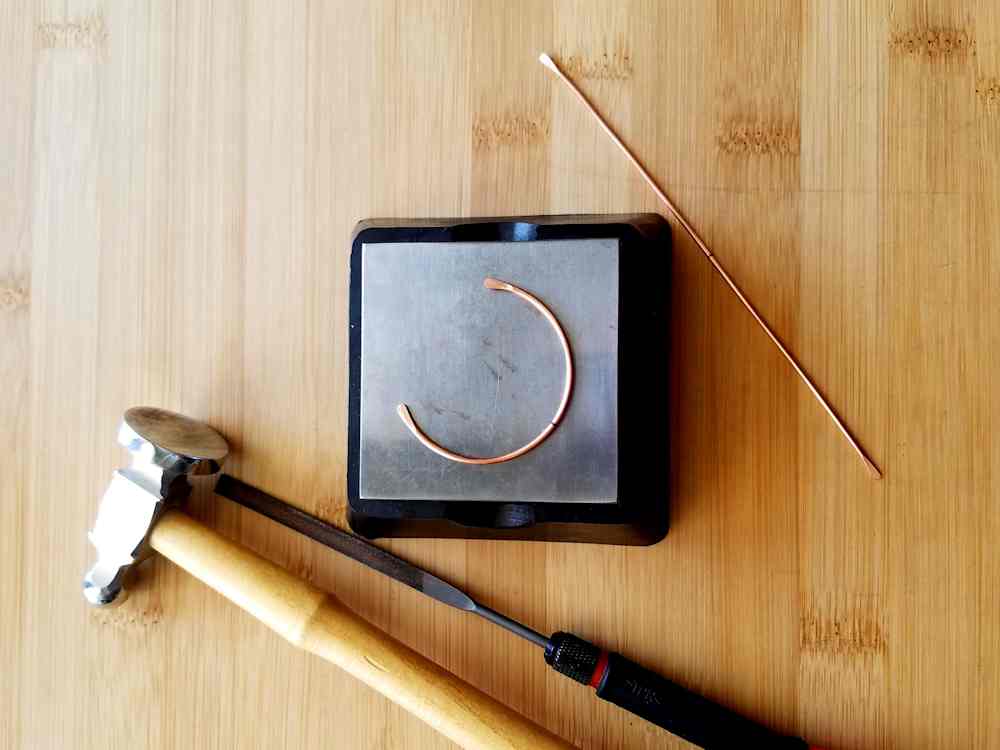
Step 6
We’re now going to form the loops on Wire 2 that will attach to your chain.
Using the 3mm step (the second smallest step) on your bail-making pliers, grasp the tip of one paddled end and gently curl it all the way around the mandrel.
Repeat on the other end making sure that the two curls face one another, as shown.
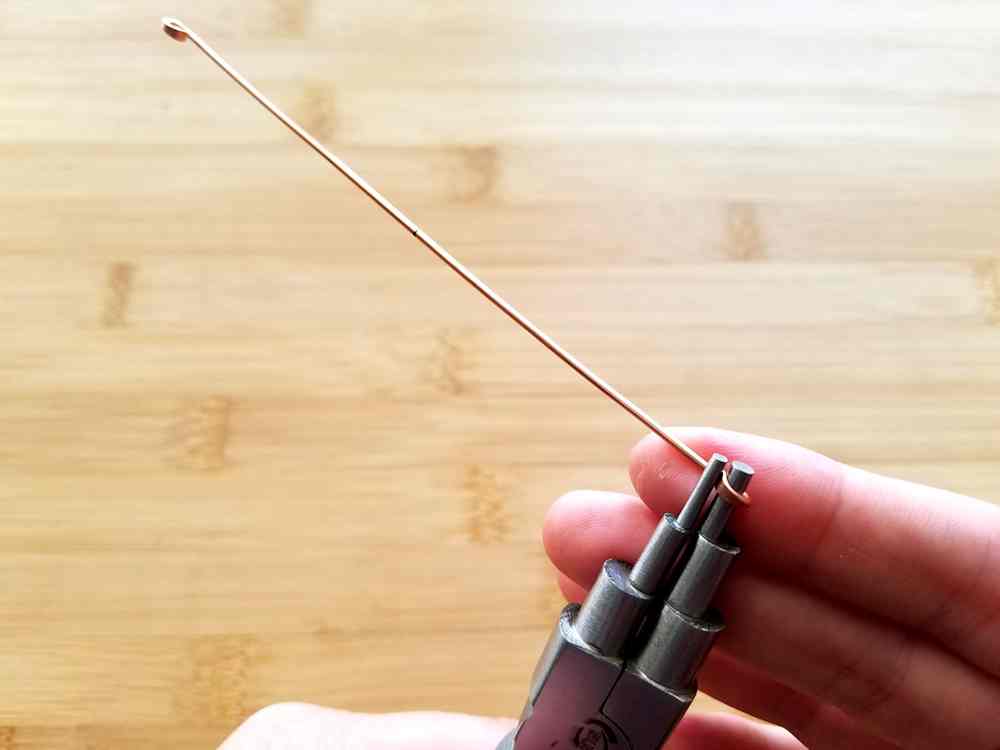
Step 7
Take the same wire you just shaped in Step 6 (Wire 2) and position one curled end of the wire at the center of the 4mm step (the third step) of your bail-making pliers. Grasp the wire just under the tight curl you made in Step 6. The rounded face of the curl should be pointing toward you.
Use your fingers to push the long end of the wire away from you and bring it all the way around the 4mm mandrel until the small curl made in Step 6 touches the straight length of the wire, as shown. Repeat on the other end to complete your shape.
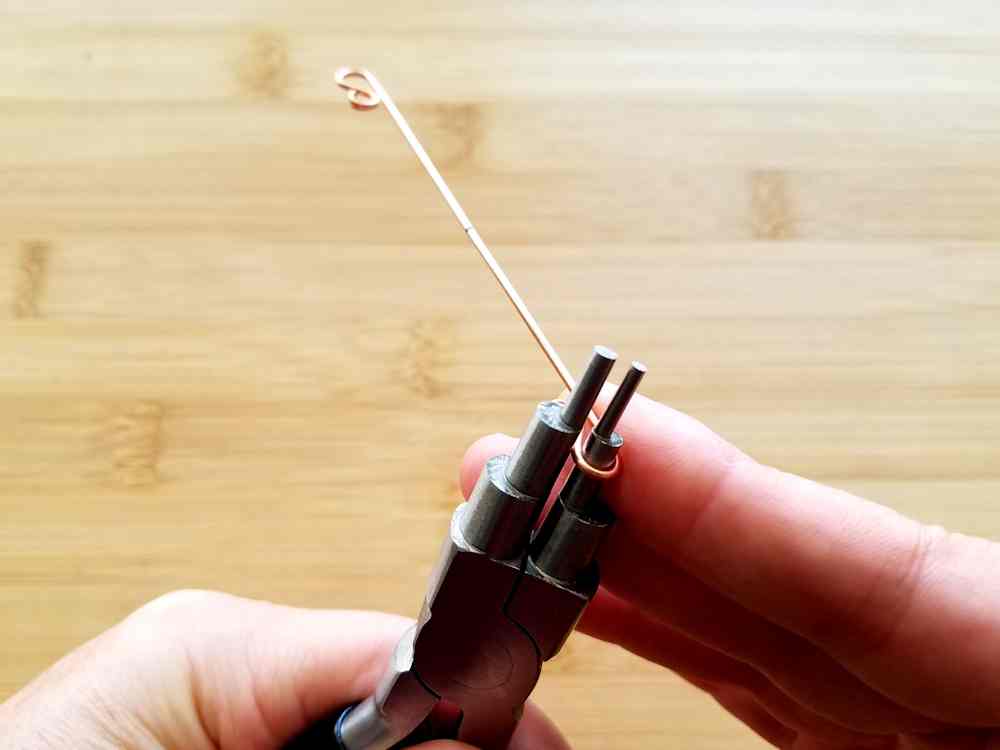
Step 8
Use your 1-1/4-inch mandrel to form a soft curve on Wire 2.
Wire 2 should nest closely around Wire 1, as shown. Test the fit and make any necessary adjustments. You may need to stretch the curve on Wire 2 until it nests neatly with Wire 1.
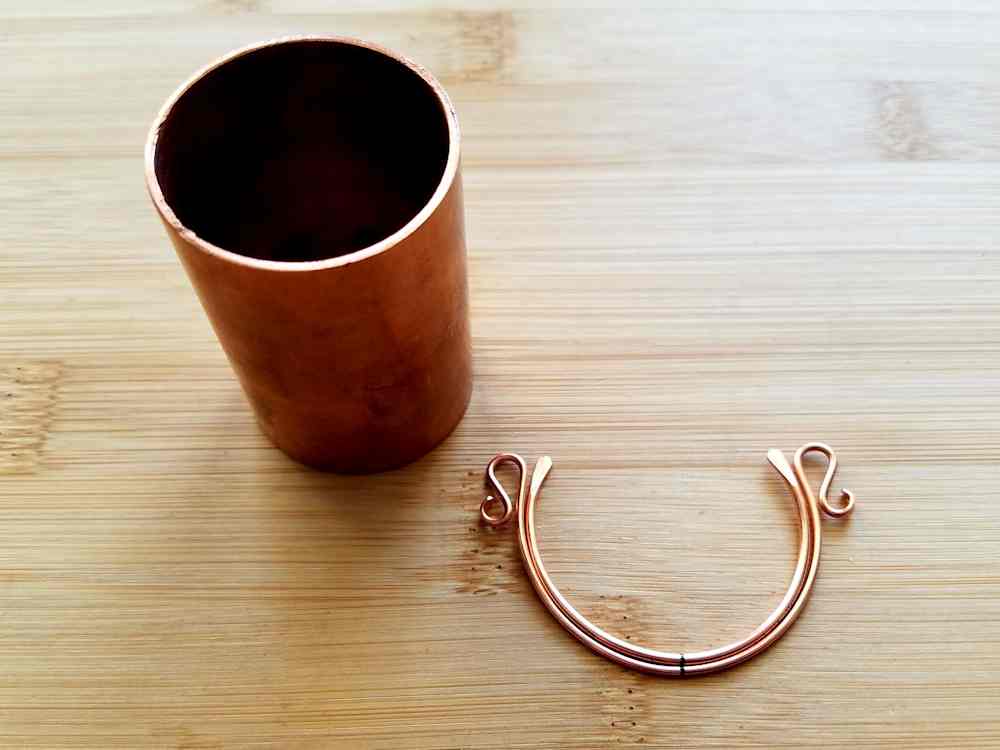
Step 9
Now that all your core wires are fully formed, we need to harden the ends of Wire 2, so it’ll retain its shape.
Using your bench block and chasing hammer, carefully flatten the curved ends of the wire. Be careful to avoid hitting the small curls with your hammer.
If hammering the curved ends opens a gap between the small curls and the core wire, gently squeeze that gap closed with the 3 mm step of your bail-making pliers. We’re going to lash those ends to the core wire in the next section of this tutorial, so don’t worry if you can’t close that gap completely.

Your frame wires are now complete and ready to weave together. Before proceeding, nest your core wires together and line up the center marks.
The wires should nest neatly together, and everything should be lined up symmetrically. If not, make any necessary adjustments now and mark new centerlines on your core wires.
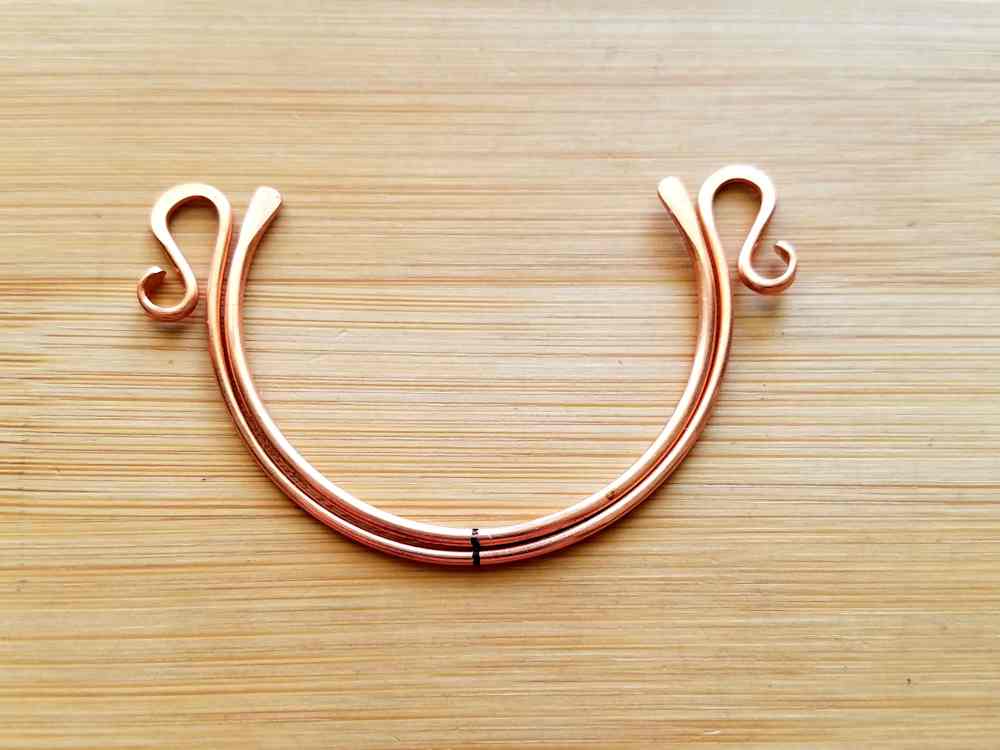
Weave the Core Wires Together
Step 1
You’ll need about 8 feet of dead soft 28g wire for weaving.
I like to work off a bobbin when dealing with this much wire. Wind your bobbin with more than enough wire to complete the weaving for this project.
I usually wind my bobbins with between 50 and 100 feet of wire, and then I use that bobbin for several projects.
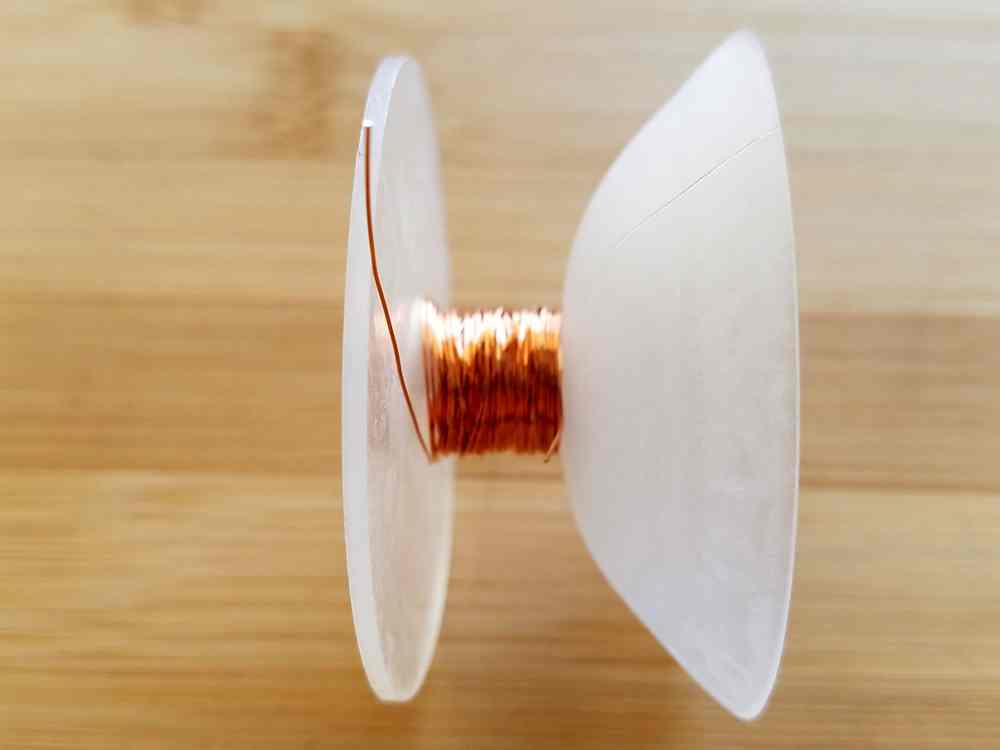
Step 2
Before you begin weaving, you’ll need to determine the points on Wire 1 that align with the horizontal hole in your focal bead. We’re going to suspend the bead with the weaving wire while seamlessly continuing the weave.
Slip a straight piece of scrap wire through the hole on your focal bead so the wire comes out on either side of the bead. Then center Wire 1 around the bead, as shown.
Mark the points on each side of the hole in the bead on Wire 1 with your fine-point permanent marker. Make sure the center mark on Wire 1 is centered between those two marks.
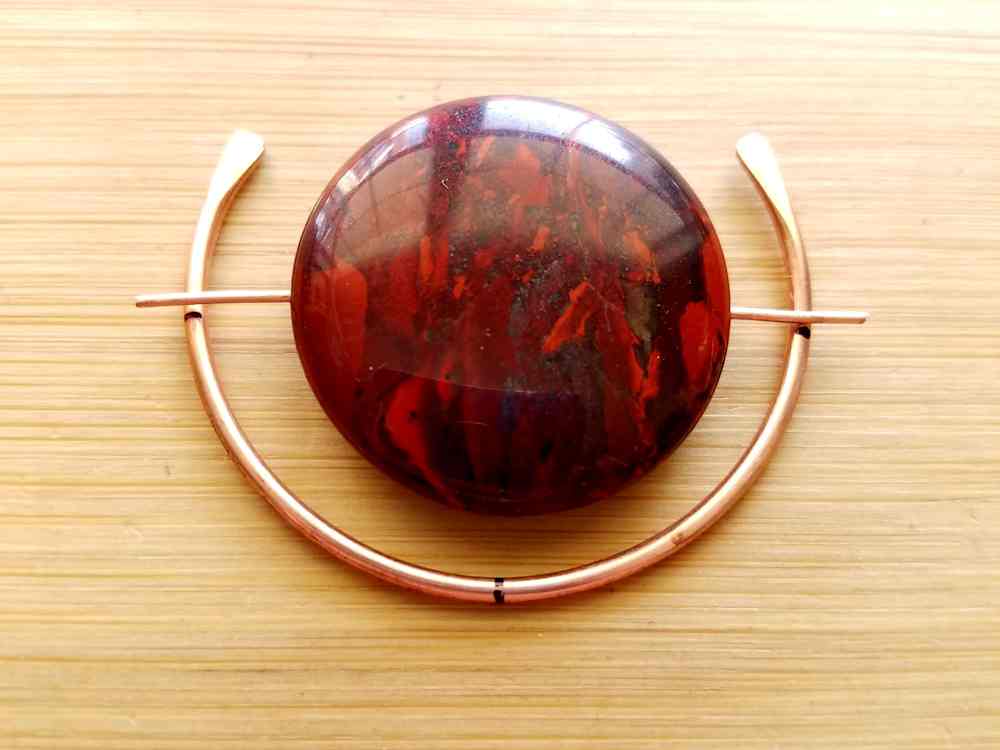
Step 3
Pull about 4 feet of weaving wire off your bobbin and position your core wires near the bobbin. Begin weaving the two core wires together using the Modified Soumak Weave.
Start at the center marks and weave in one direction until you reach one of the marks you made in Step 2. Make sure your center marks still line up. If not, slide the wires back into alignment.
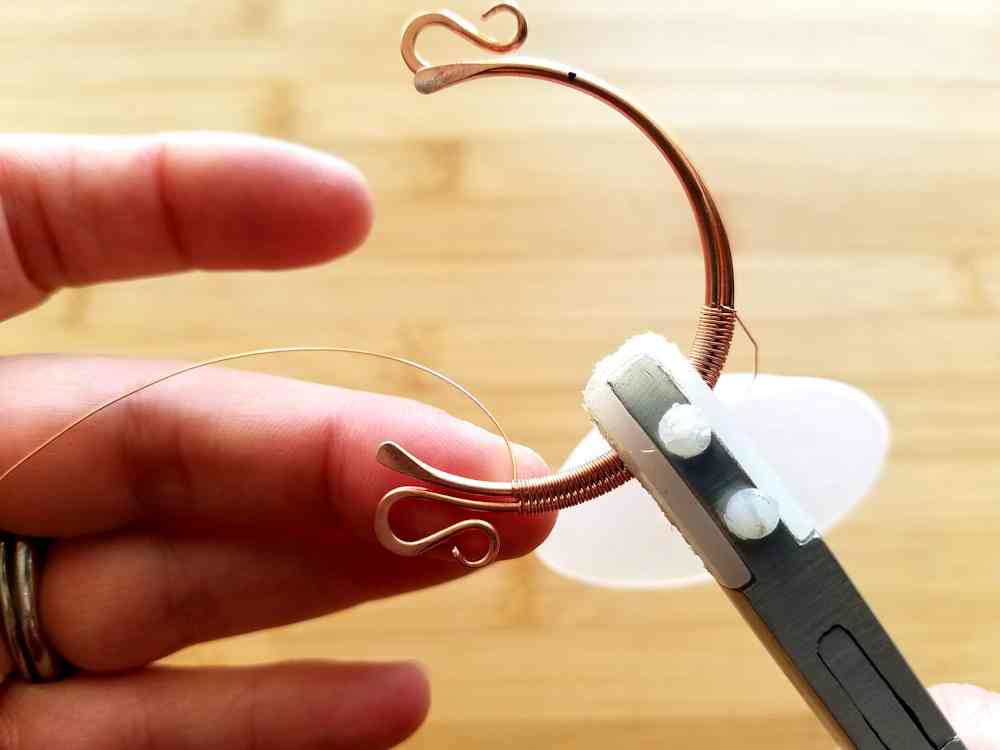
Step 4
Flip your bead frame over and repeat Step 3 on the other side of the frame.
Again, make sure your core wires are aligned on the center marks.
If you’re making a silver pendant and you’re weaving with fine silver wire, or if your focal bead won’t accommodate two passes of 28ga copper weaving wire, skip ahead to the Alternate Bead Suspension Method section of this tutorial now. Otherwise, continue to the next step.
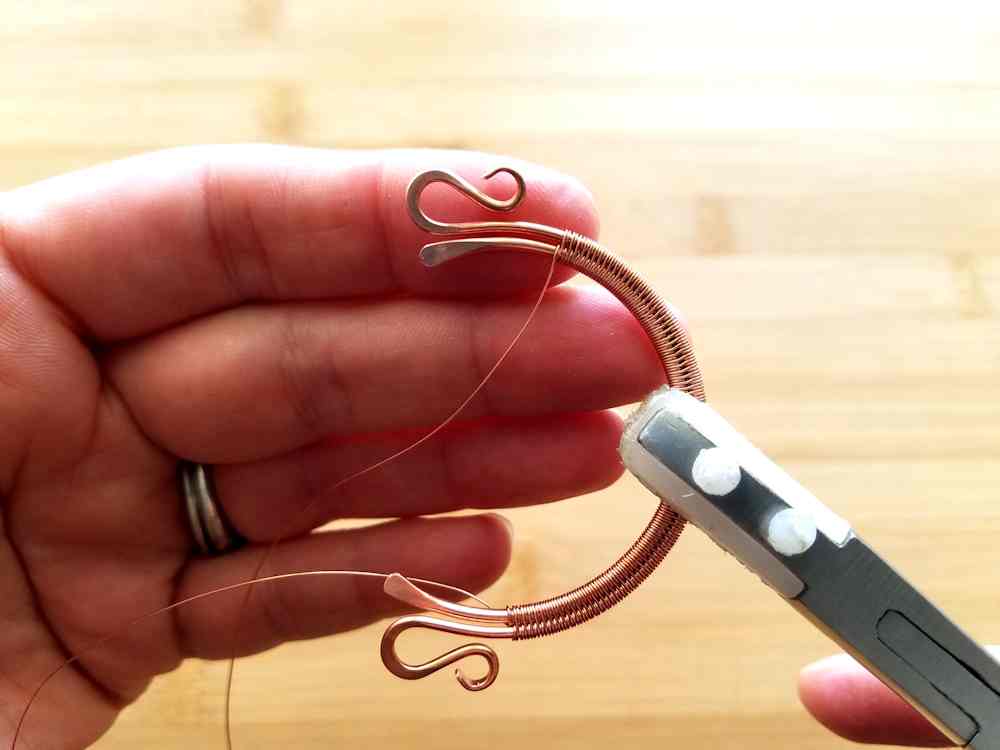
We’re now going to suspend the focal bead from the frame by integrating it seamlessly into the weave. This part takes some patience and determination the first time you do it. Work slowly and carefully so you don’t create kinks in your weaving wire or you’ll compromise the strength of your weaving wire.
Step 5
The weave should be centered on your bead frame between the two marks on Wire 1 that indicate your focal bead’s hole position. There should be one wire laying on top of Wire 1 and one wire behind, as shown.
Hold your focal bead in place and double-check that the hole position is correct. You want your weaving wire to pass straight through the hole. If necessary, complete another pattern repeat or two until the weaving wires are in the best position to pass straight through the bead
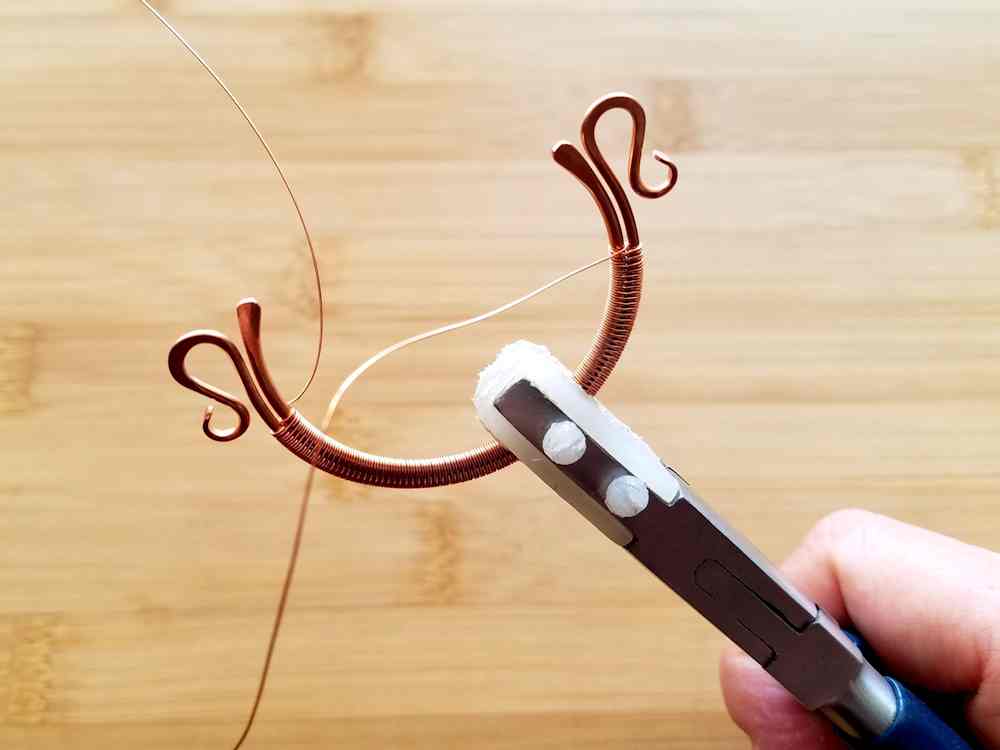
Step 6
Again, one end of your weaving wire should be in front of Wire 1 while the other is behind Wire 1. Pay attention to this pattern because you’re going to continue the weave exactly where you left off after passing each end of the weaving wire through the hole on the bead.
Place your bead flat on the table with the side that you prefer to be the front facing you. Take the weaving wire on the left side of the bead frame and pass it from left to right through your two spacer beads and your focal bead.
Repeat on the right side of the bead frame, passing the wire through all three beads from right to left.
You should now have two wires passing through your three beads, as shown.
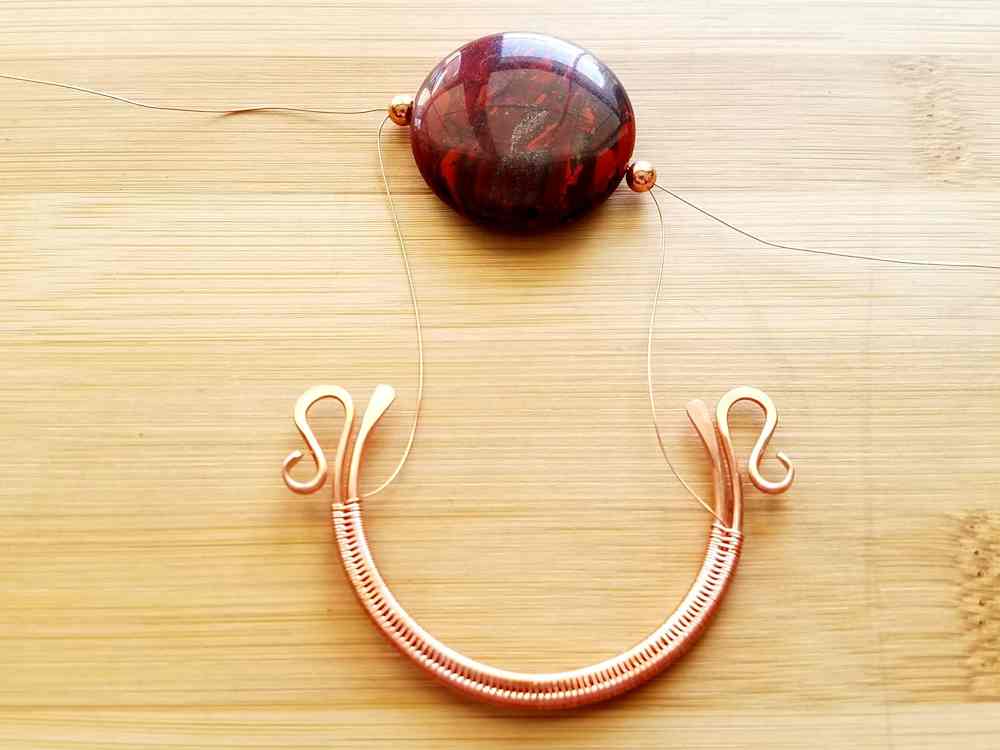
Step 7
Gently pull both ends of the wire until your beads slide down into position within the bead frame.
Work the bead into position slowly and carefully to avoid creating kinks in your wire. Once the beads are in place, pull both ends of the wire until the bead sits snugly in the frame with no slack in the wires.
You may need to loosen or tighten the curve of your bead frame at this point. Your goal is to shape the frame so that the three beads fit perfectly between the two sides of the frame with no gaps.
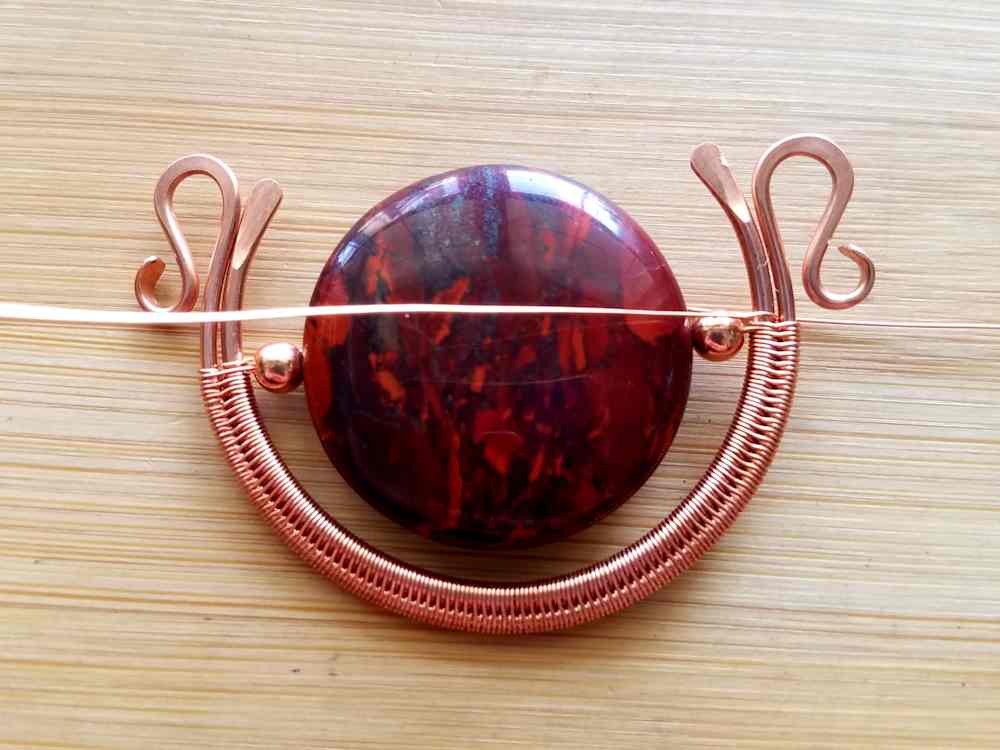
Step 8
If the hole on your focal bead will accommodate four passes of wire, complete one full weave repeat and then pass each end of your weaving wire through the bead again, just as you did in Steps 6 and 7.
Again, go slowly to keep your wire from forming kinks. Once both ends of the wire have been successfully threaded through the bead, continue your weave seamlessly where you left off.
If your bead won’t accommodate four passes of wire and you’re confident that two passes will bear the weight of your stone (mine didn’t and I am), continue to the next step. Otherwise, consider using the alternate bead suspension method below.

Step 9
Keep weaving in pattern until you reach the small curl on Wire 2. Then lash that curl to the frame with one pattern repeat.
Continue weaving the two core wires together until you reach the bottom of the hammered paddle on Wire 1. Then wrap the weaving wire around Wire 2 three times to secure it.
Break your weaving wire at the point where it passes between the two core wires. Repeat on the other side of the bead frame.
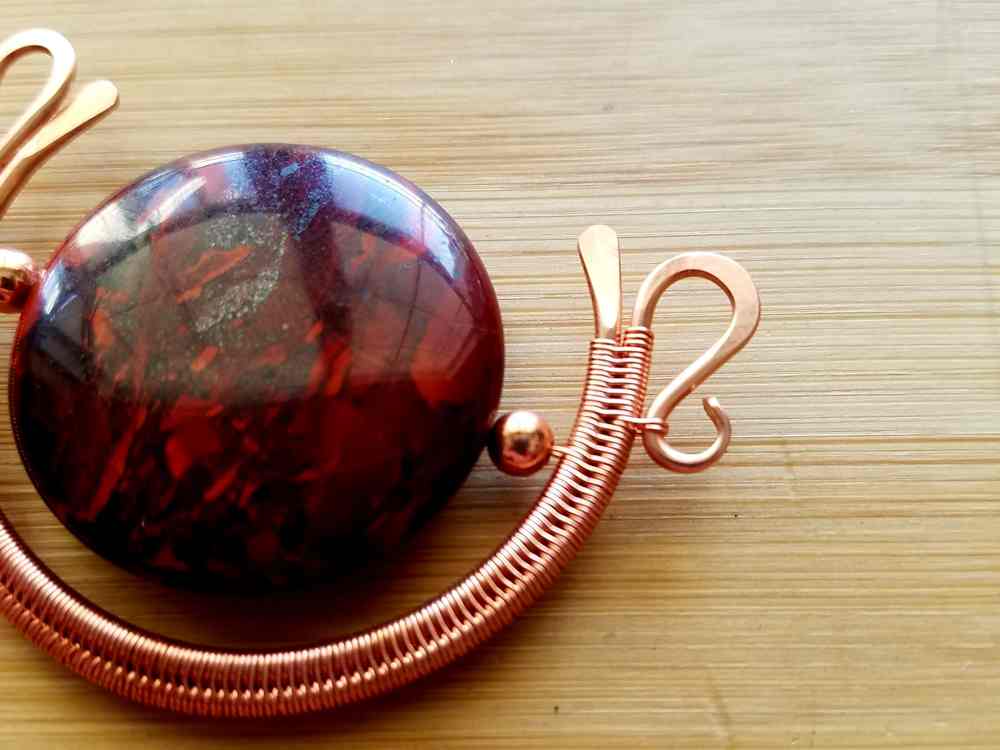
Step 10
The core wires of your bead frame may naturally slip into a convex curve as you’re weaving the frame, but once the weaving is complete, we need to lock in that shape, which creates a bezel effect around the focal bead.
Use your fingers to gently push Wire 1 forward and Wire 2 back. Once you’re satisfied with the shape of your bead frame, use your fingers or nylon jaw pliers to gently push the curved ends of Wire 2 back so they continue the lines of the convex curve.

Your pendant is now complete. You can finish it with a chain of your choice or proceed to the assembly section where I’ll walk you through the process of assembling the 18-inch chain I used on the sample necklace I created while writing this tutorial.

Alternate Bead Suspension Method
If you have any doubts at all that your weaving wire is strong enough to support the weight of your focal bead with two to four passes of weaving wire, you can use this alternate method to suspend your bead. Done well, this method maintains the seamless look of the weave while securing your focal bead with a heavier gauge wire.
I strongly recommend this method for silver pendants where you’re using fine silver wire for weaving. Fine silver wire simply isn’t strong enough to support the weight of a gemstone bead. I learned that lesson the hard way, so I always use this alternate method to suspend my focal beads with sterling silver wire on the rare occasions that I make silver jewelry.
Step 1
Continue the weave seamlessly where you left off on both sides of the bead frame. We’re going to completely weave the bead frame before suspending the focal bead.
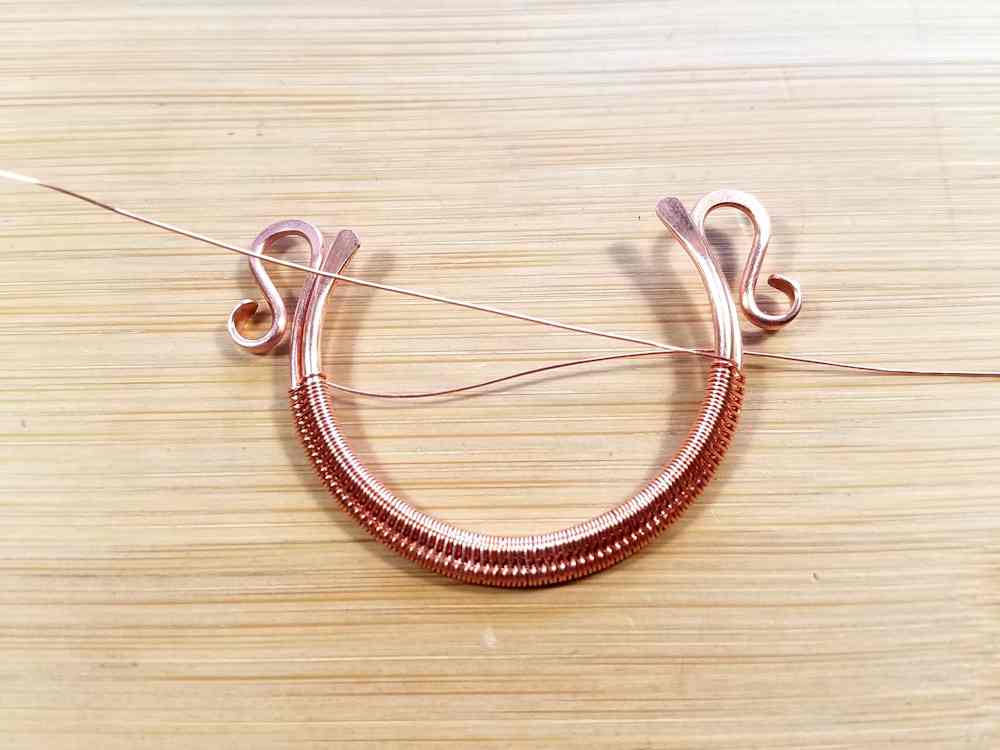
Step 2
Keep weaving in pattern until you reach the small curl on Wire 2. Then lash that curl to the frame with one pattern repeat.
Continue weaving the two core wires together until you reach the bottom of the hammered paddle on Wire 1. Then wrap the weaving wire around Wire 2 three times to secure it. Break your weaving wire at the point where it passes between the two core wires. Repeat on the other side of the bead frame.

Step 3
The core wires of your bead frame may naturally slip into a convex curve as you’re weaving the frame, but once the weaving is complete, we need to lock in that shape, which creates a bezel effect around the focal bead.
Use your fingers to gently push Wire 1 forward and Wire 2 back. Once you’re satisfied with the shape of your bead frame, use your fingers or nylon jaw pliers to gently push the curved ends of Wire 2 back so they continue the lines of the convex curve.
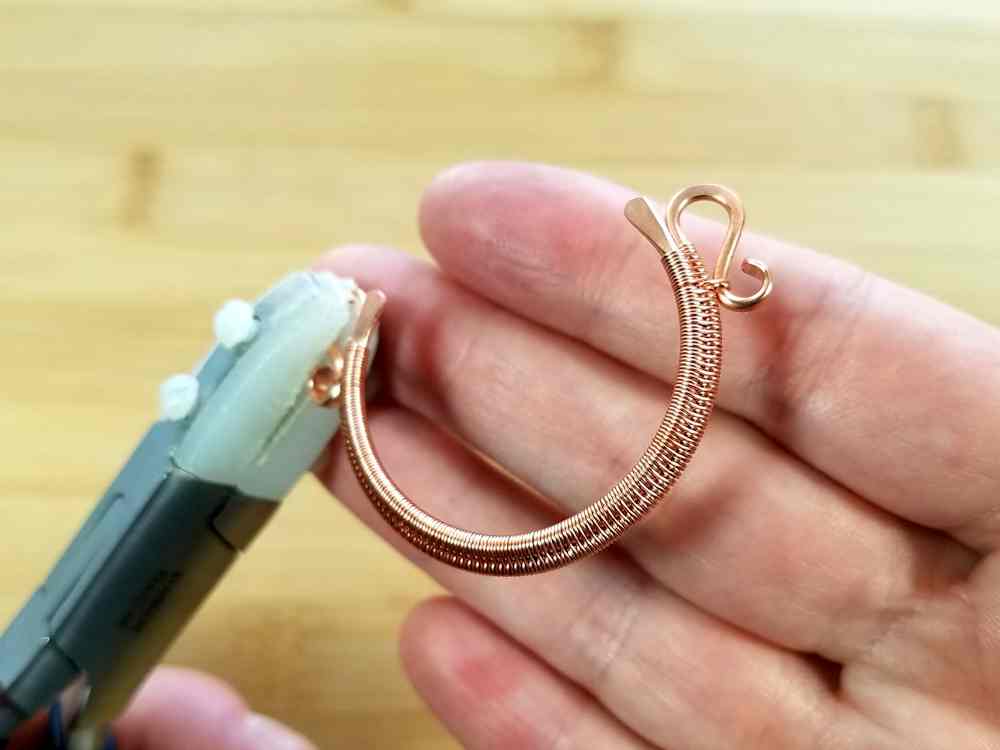
Step 4
We’re now going to suspend the focal bead within the frame.
Feed a straight piece of scrap wire through your focal bead and spacer beads. Make sure that the face of the bead that you prefer for the front is facing forward.
Position the beads within the frame and determine where you need to pierce your weave to suspend the beads. Remember, you want your suspension wire to pass straight through the beads. Use your fine-point marker to mark the points on your bead frame where you need to pierce the weave.
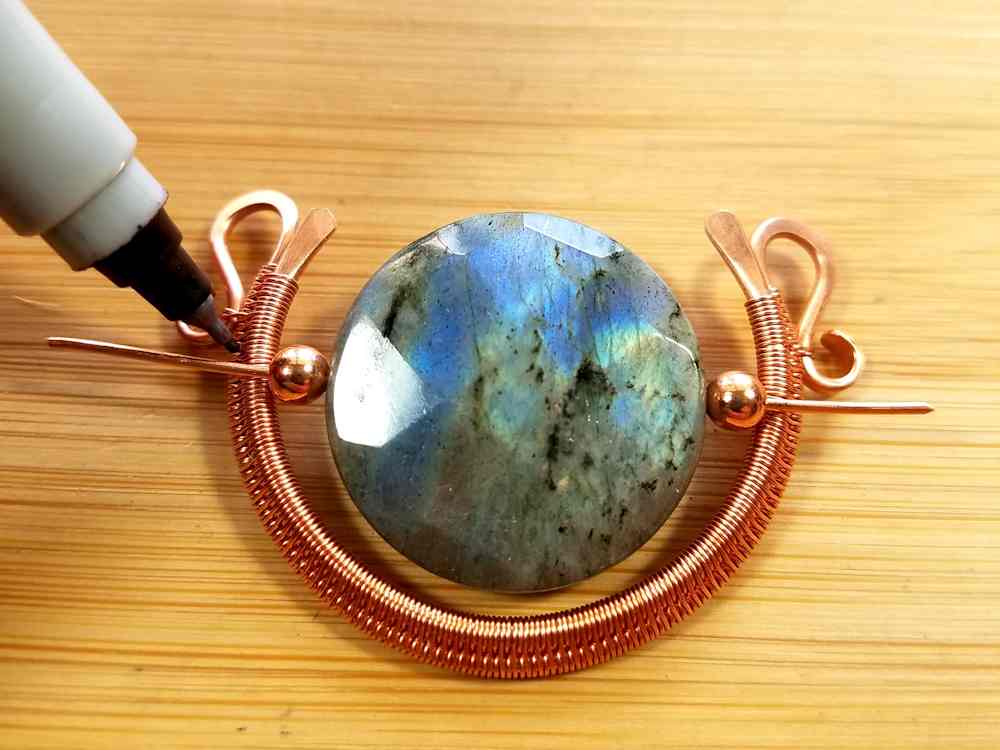
Step 5
Use a sharp beading awl to pierce your weave between core wires 1 and 2 on both sides of the bead frame at the points you marked in Step 4.
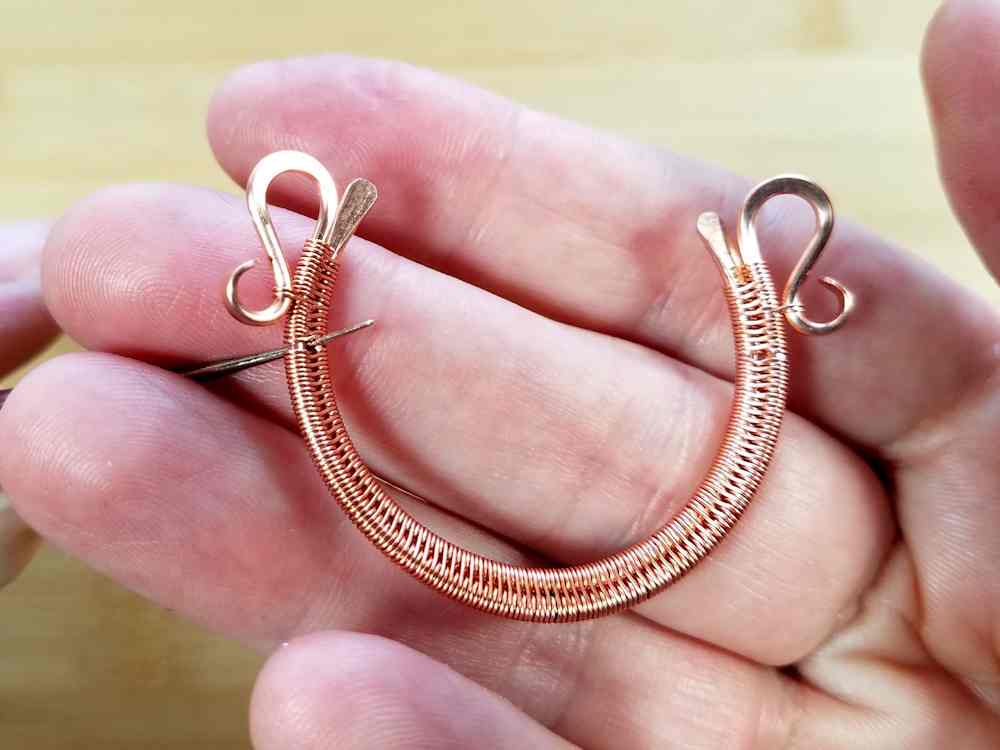
Step 6
Cut a piece of 24ga wire about 6 inches long. If you’re making your pendant in silver, be sure to use sterling silver wire to suspend your bead.

Step 7
Feed one end of your 24ga wire through the hole you pierced on one side of the bead frame from front to back. Bring the short end of your wire from the back and wrap it tightly twice around the long end of the wire. Make your wraps as close to the inside edge of the bead frame as you can get them, as shown.
Break the 24ga wire tail on the back side of the bead frame. Tuck in the wire end with your chain nose pliers, if necessary.

Step 8
String your spacer beads and your focal bead onto the long end of the 24ga wire. Then feed the 24ga wire through the remaining hole on your bead frame. Again, from front to back.
Pull your suspension wire tight and make sure the beads are suspended neatly within the bead frame. Then secure your suspension wire with two tight wraps between the spacer bead and the bead frame.
Break the wire tail on the backside of the bead frame. Tuck in the wire end with your chain nose pliers, if necessary.

Your pendant is now complete. You can finish it with a chain of your choice or proceed to the next section where I’ll walk you through the process of assembling the 18-inch chain I used on the sample necklace I created while writing this tutorial.
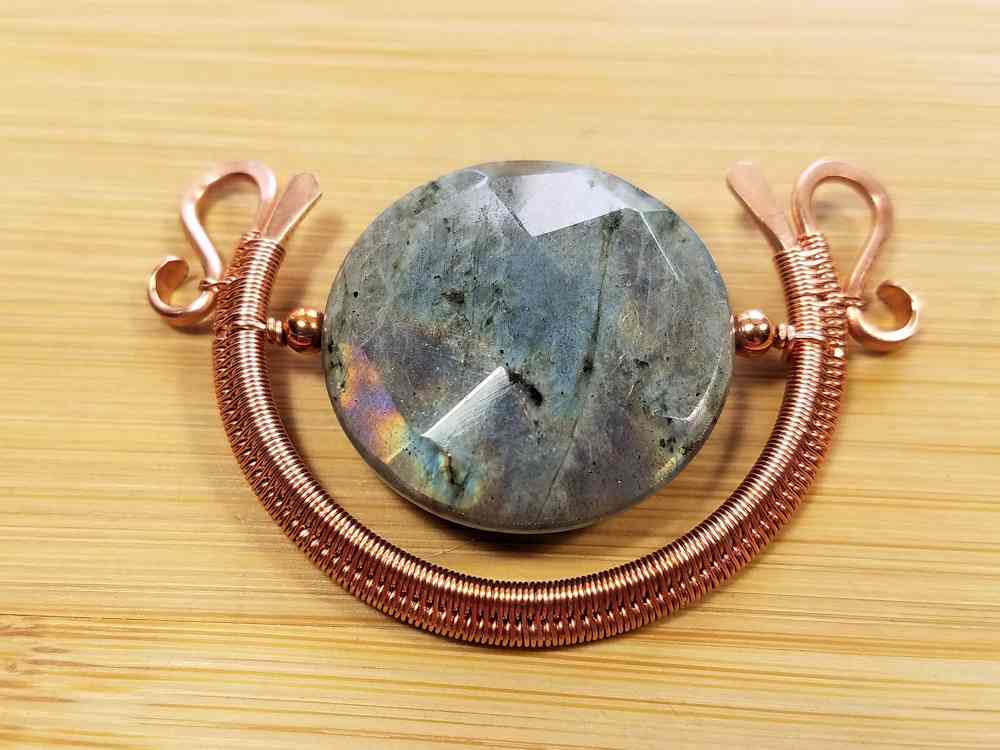
Assemble the Chain
Step 1
Cut two pieces of chain 7.25 inches long.

Step 2
Cut four pieces of 22ga half-hard wire 2-1/2 inches long. Mark each wire at 1 inch from one end. This is where you’ll begin your wrapped loops.
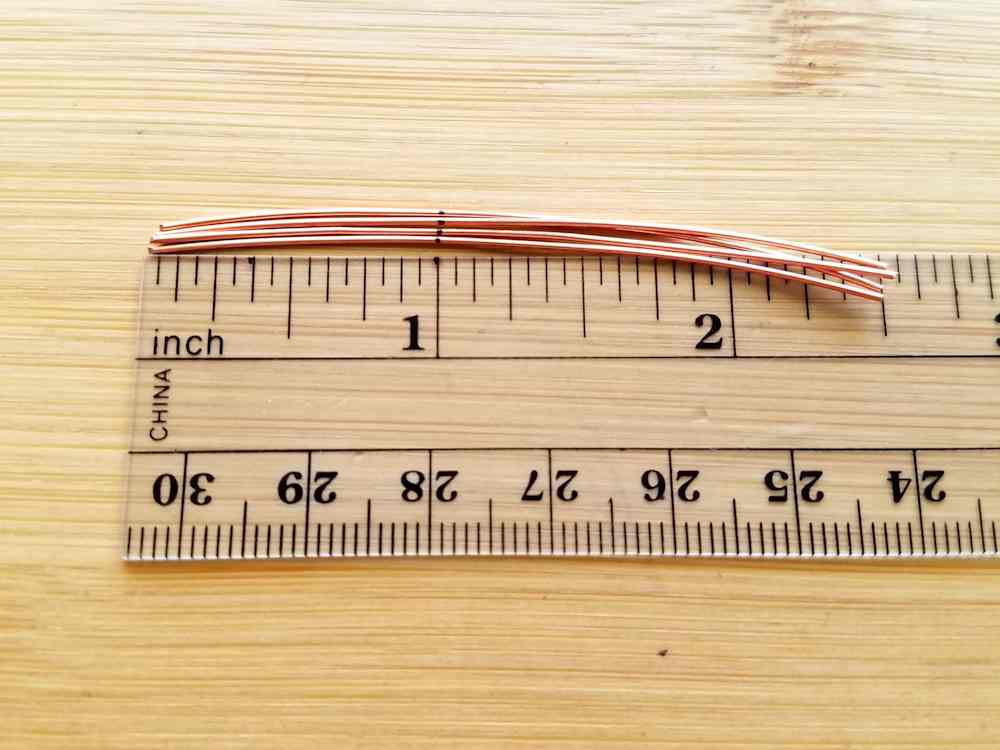
Step 3
Begin a wrapped loop and thread it through one of the large loops at the top of your pendant. Finish wrapping the loop.
Repeat on the other side of the frame.
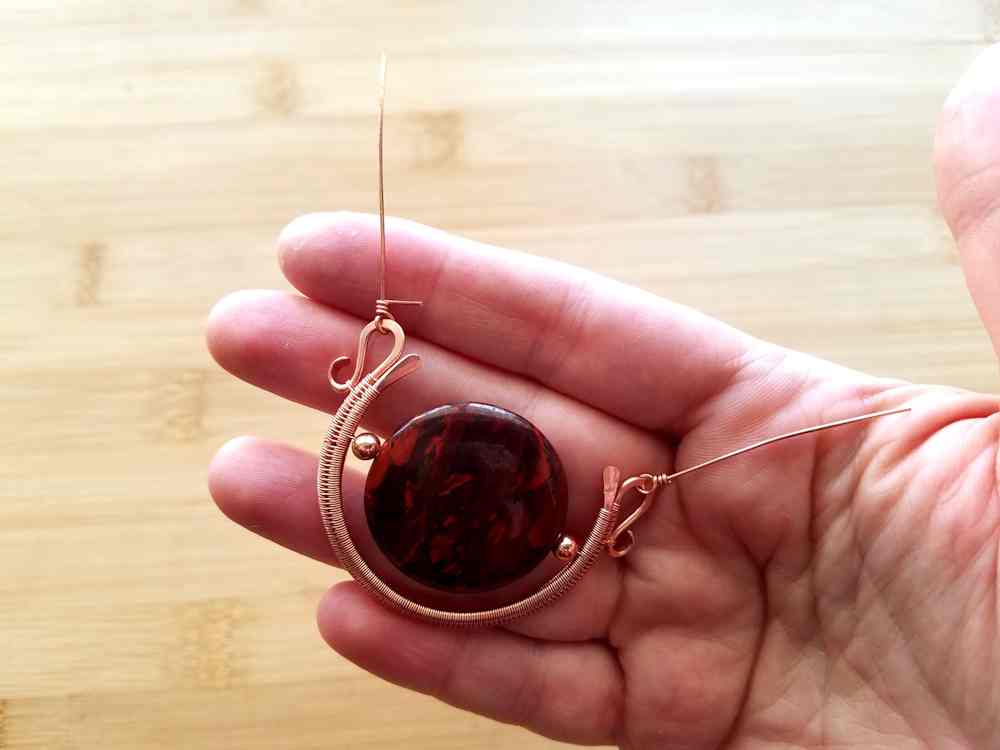
Step 4
Thread one or more accent beads onto one of the wrapped loops you just added to the top of your pendant. I used two 4mm Czech glass Druk beads.
Begin a second wrapped loop just above the bead(s) and thread one end of your chain onto the loop. Close the loop with the same number of wraps that you used on the other side of the connector.
Repeat on the other side of the pendant.

Step 5
Begin another wrapped loop and thread it onto the other end of the chain you just connected to your pendant. Finish wrapping that loop.
Thread your accent beads onto the wrapped loop and begin a second wrapped loop just above the beads. That end will connect to one side of your clasp.
Repeat on the second half of the chain.

Step 6
Using 6 inches of 18ga half-hard wire, make a Medium Easy Infinity Clasp. Connect one half of the clasp to each of your remaining open loops.
You can find a downloadable PDF tutorial for my Easy Infinity Clasp in my Etsy shop, or check out the free version of that tutorial right here on my blog.
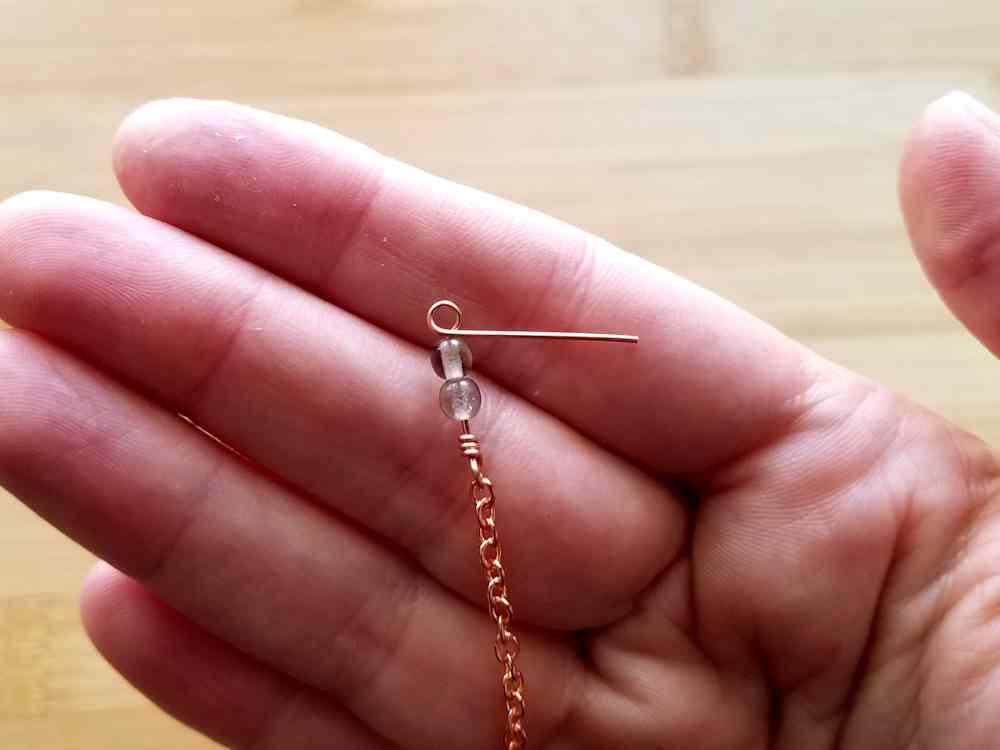
That’s it. You’ve just completed your Egyptian Sun Pendant! Put it on and admire your work. It’s always a good idea to wear test new pieces. Make any final adjustments before giving the piece its final finish and polish.

Variations of the Kinetic Egyptian Sun Pendant
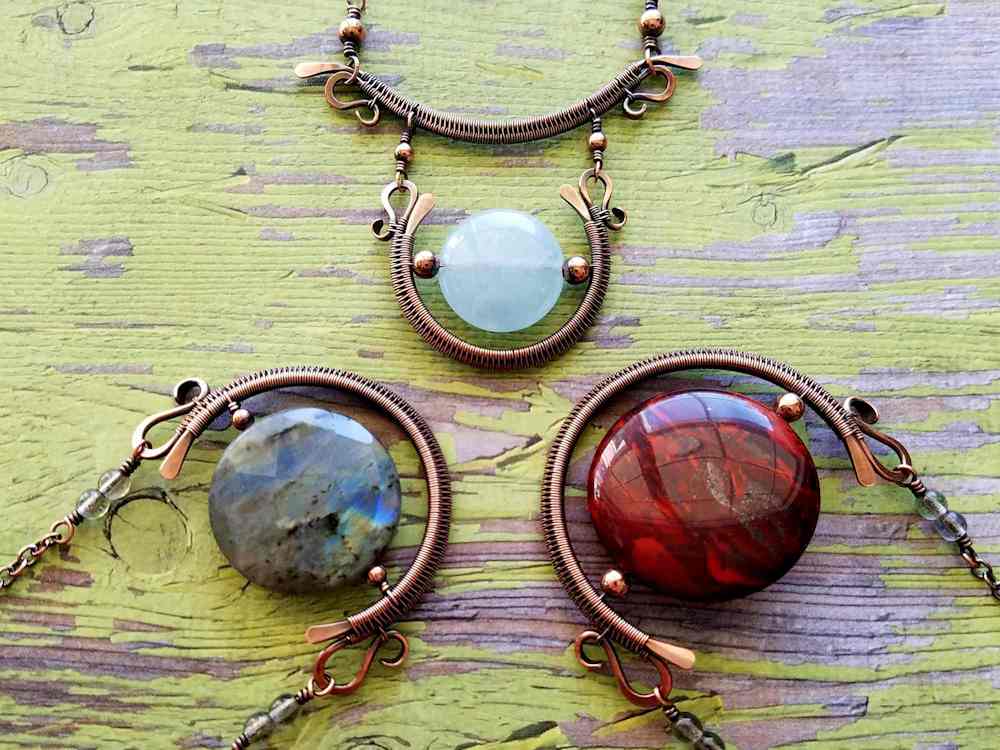
Beads that work well for this pendant are easy to locate, and this design can be easily adapted to center-drilled coin beads of nearly any size. The bead frame, as sized in this tutorial will accommodate focal beads from 30mm to 35mm. All you need to do to accommodate a 35mm stone is to reduce the size of your spacer beads from 4mm to 2mm.
Resizing the Bead Frame
In order to modify this frame to fit focal beads that are smaller than 30mm or larger than 35mm, first, consider the size of your focal bead. I’ve made this design using stones as small as 17mm (see the dyed quartz pendant pictured above (top center) and as large as 45mm. I used a 3/4-inch mandrel to create the bead frame for the dainty dyed quartz pendant.
The Egyptian Sun Pendant pictured above (bottom left) features a 25mm faceted Labradorite bead. I used my 1-inch copper mandrel to make the frame for this piece, and I shortened the cut lengths of my core wires by 1/2 inch (Wire 1 is 3-inches long and Wire 2 is 5-inches long). Because I used the alternate suspension method on the Labradorite pendant, I also reduced the spacer beads from 4.0mm to 3.0mm to make room for the wraps on the 24ga suspension wire.
For a 40mm to 45mm stone, use a 1-1/2-inch mandrel and lengthen your core wires by 1/2 inch to 4 inches for Wire 1 and 6 inches for Wire 2.
Adjusting Core Wire Gauges and Cut Lengths
Remember, your goal is to make sure that the size of your bead frame is in balance with the size of your bead. So be sure to consider the size of your core wires when modifying the size of the bead frame. You can use lighter or heavier gauge core and weaving wires to make a frame suitable for each bead. I used 16ga and 18ga core wires with 28ga weaving wire for the dainty dyed quartz necklace shown above (top center).
To determine the lengths for your core wires, use a fabric measuring tape to measure the circumference of your focal bead. Then subtract 1/2 to 1 inch from that measurement to get the length of your first core wire. Finally, add about 2 inches to the Wire 1 length for your second core wire.
Don’t forget to keep good notes when modifying the wire gauges or the cut lengths for custom sized bead frames so you can repeat your modified Egyptian Sun Pendant designs.
Combine With Other Wire Woven Elements
Experiment with this design. You can even combine this design with other wire woven components. Notice that I suspended the dainty blue quartz pendant pictured above (top center) from a variation of my Delicate Bar Pendant. As always, that tutorial is available for free on my blog or for a small fee in my Etsy shop.
Finishing Suggestions
I antiqued the Egyptian Sun Pendant that I made while writing this tutorial with Liver of Sulfur (LOS), and then I burnished the patinated piece with super fine steel wool (Grade #0000) in a warm bath of water and original Blue Dawn dish soap. The steel wool brought back the bright copper highlights on the high spots.
Once that’s done, I rinsed the jewelry thoroughly to remove any particles of steel wool, and then I put my necklace in a tumbler barrel filled with warm water and a generous squirt of Blue Dawn. I tumbled each piece for about two hours.
If you’re new to wire weaving, read this detailed tutorial that walks you through my 7-step patina process. And if you’re wondering why I recommend tumble polishing specifically, check out this post. Also, be sure to clean your stainless steel shot regularly. Clean shot is necessary to achieve the best finish on your tumble-polished jewelry.
One last bit of tumbler advice before you go. Always make sure that any beads or stones that you use for your jewelry are safe to tumble. I don’t recommend tumbling natural pearls, soft gemstones, ceramic beads, or glass beads with polymer coatings, such as glass pearls and certain frosted-look glass. If you’re not sure if your beads can handle the tumbler, run a test tumble with a bead that you’re willing to sacrifice.
Discover More Behind Door 44
Thanks so much for joining me today. I hope you enjoyed creating my pretty and versatile Egyptian Sun Pendant. If you’d like a printable PDF version of this tutorial, you can find it here.
Would you like more wire jewelry goodness?
I like to share useful wire weaving tips and tricks on my social media channels, and we have some great conversations about wire jewelry in my private Facebook Group. Also, be sure to connect with me @door44studios on Instagram, and Facebook to keep up with everything that’s happening behind Door 44. And if you haven’t already done so, be sure to subscribe to my YouTube channel where you’ll find new wire jewelry videos weekly.
Until next time, go make something beautiful!

Pin the Egyptian Sun Pendant Tutorial for Later
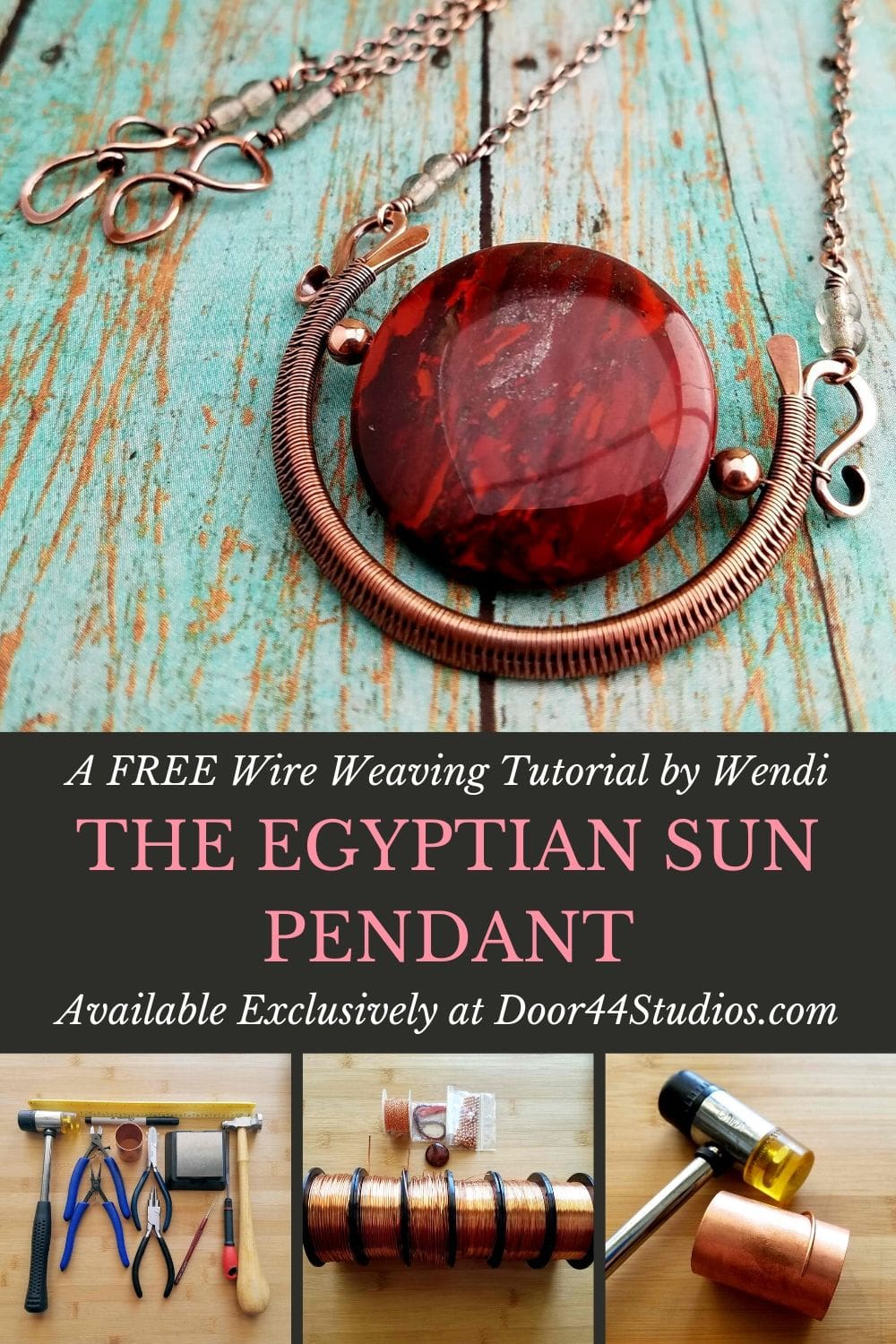


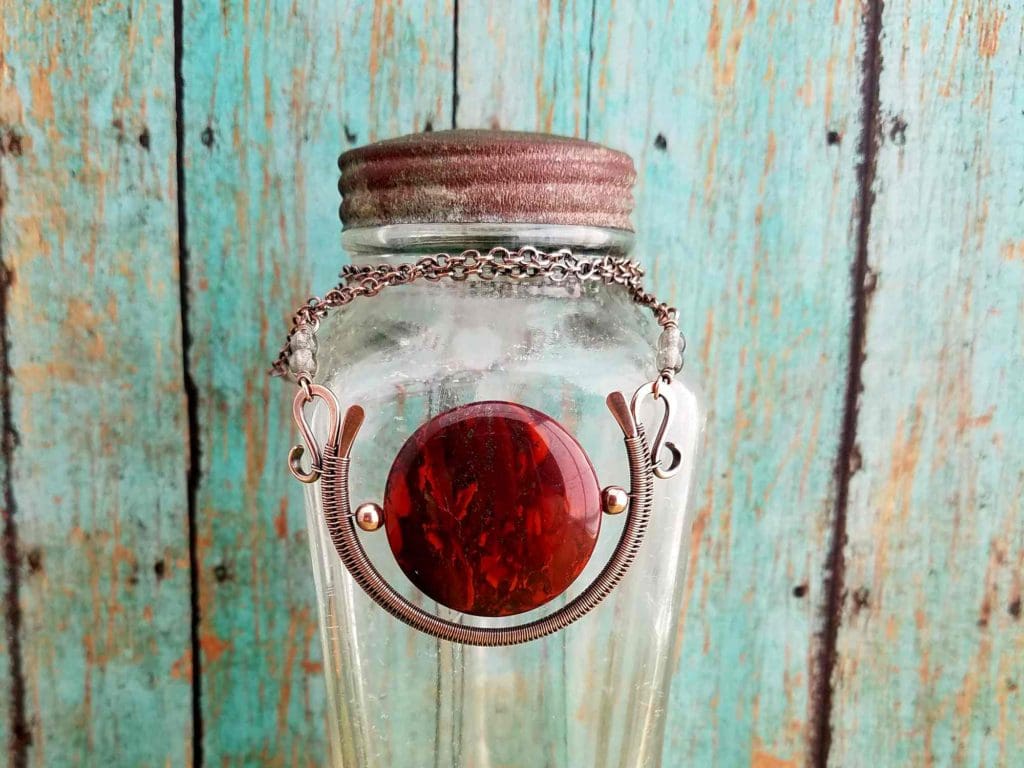
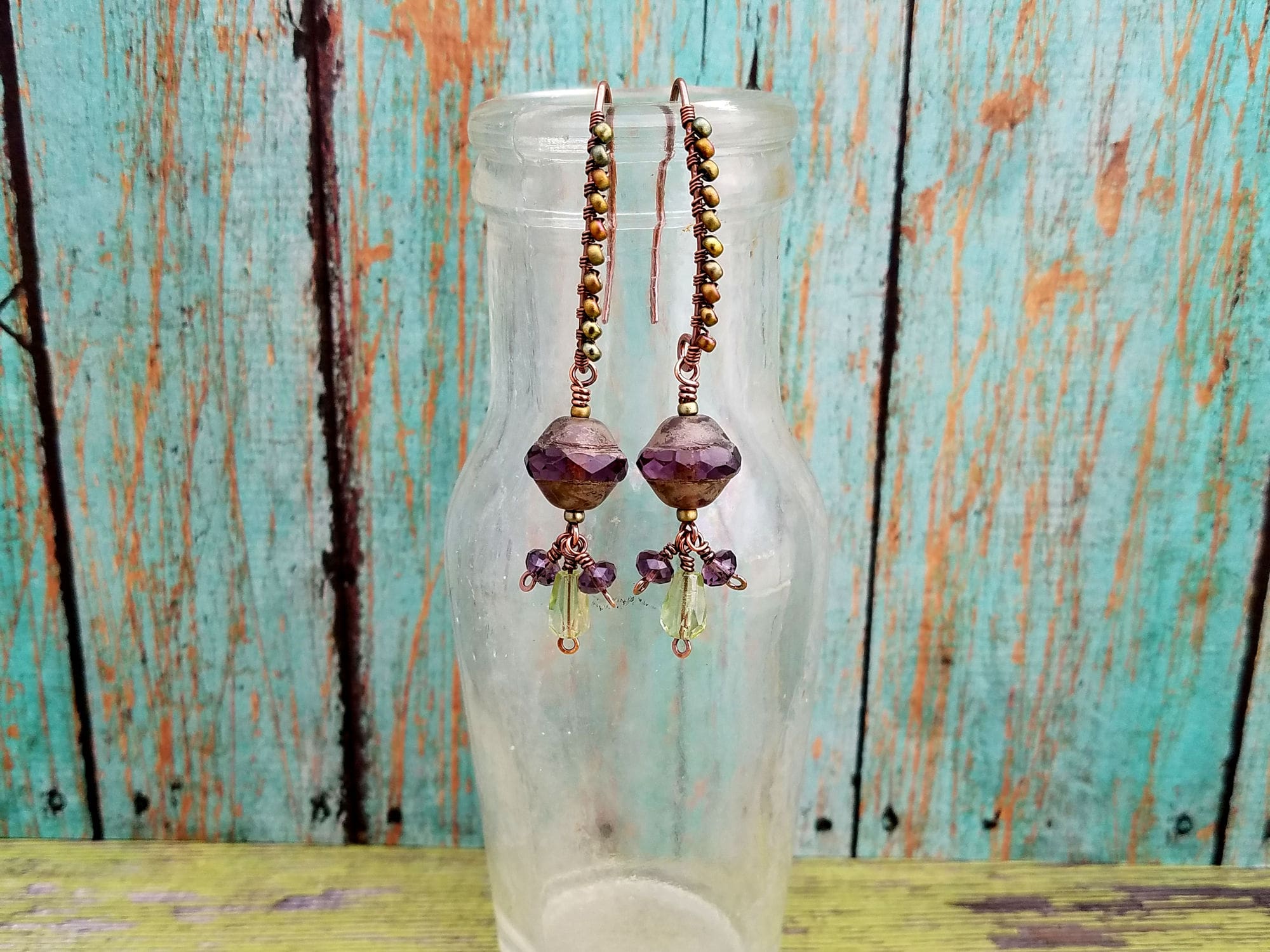
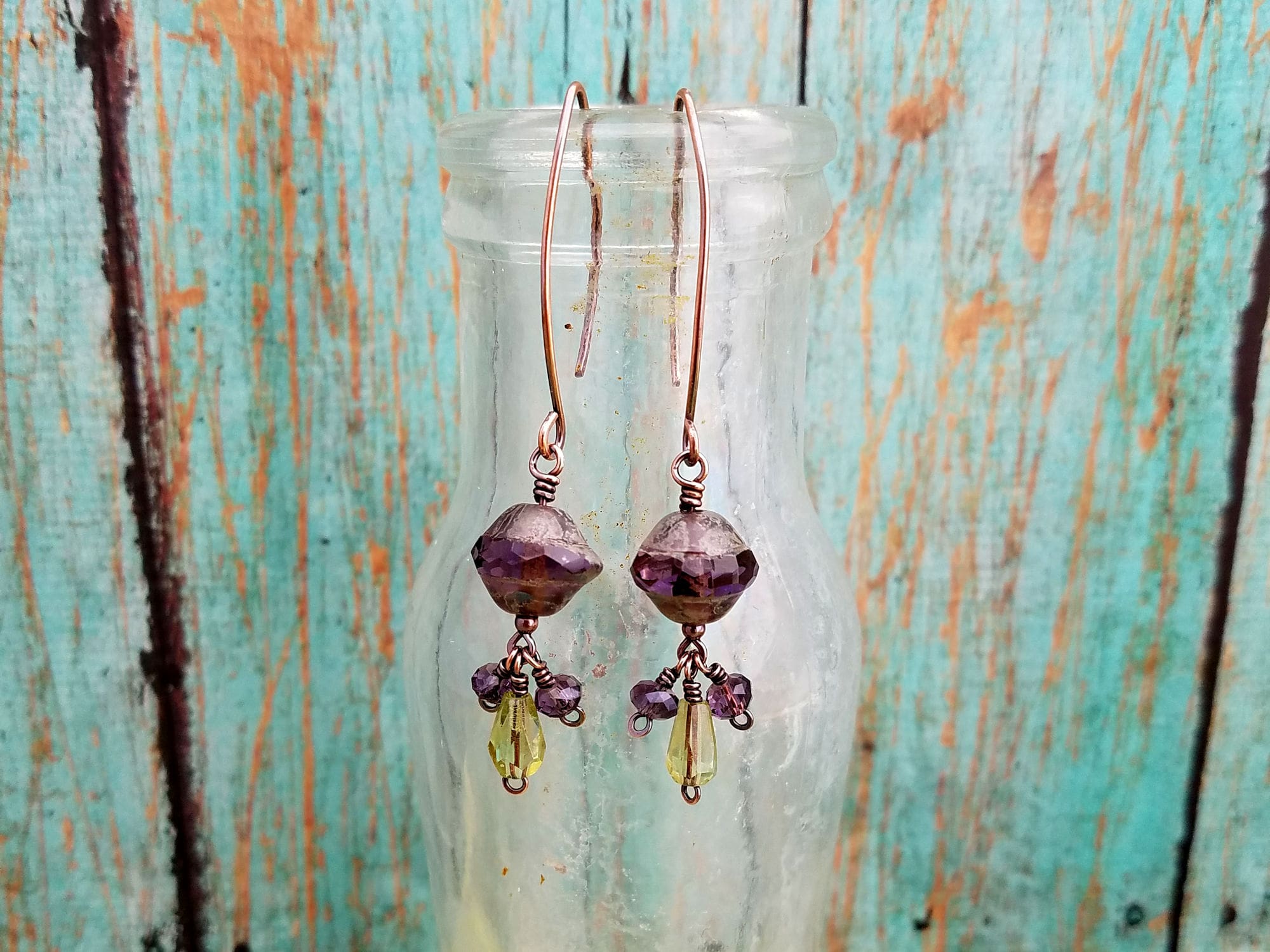
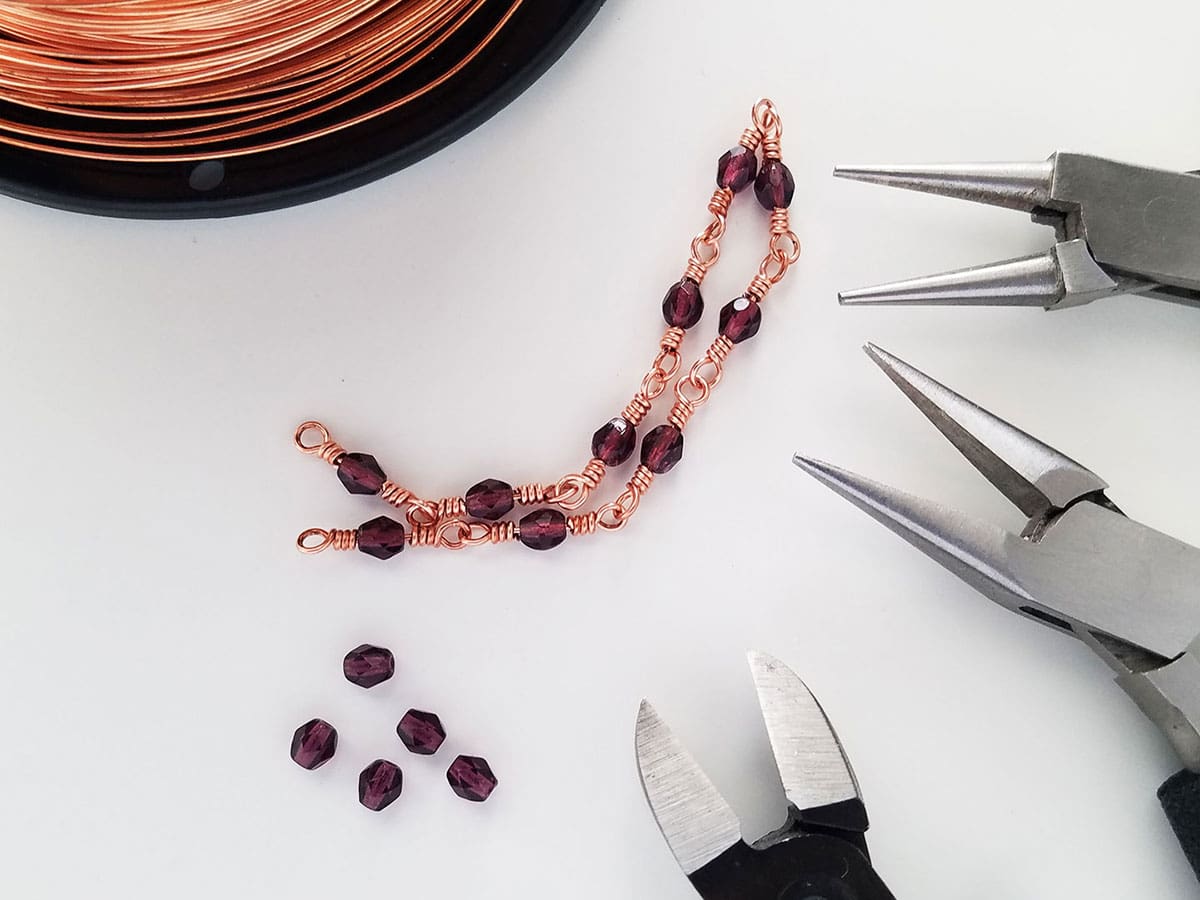

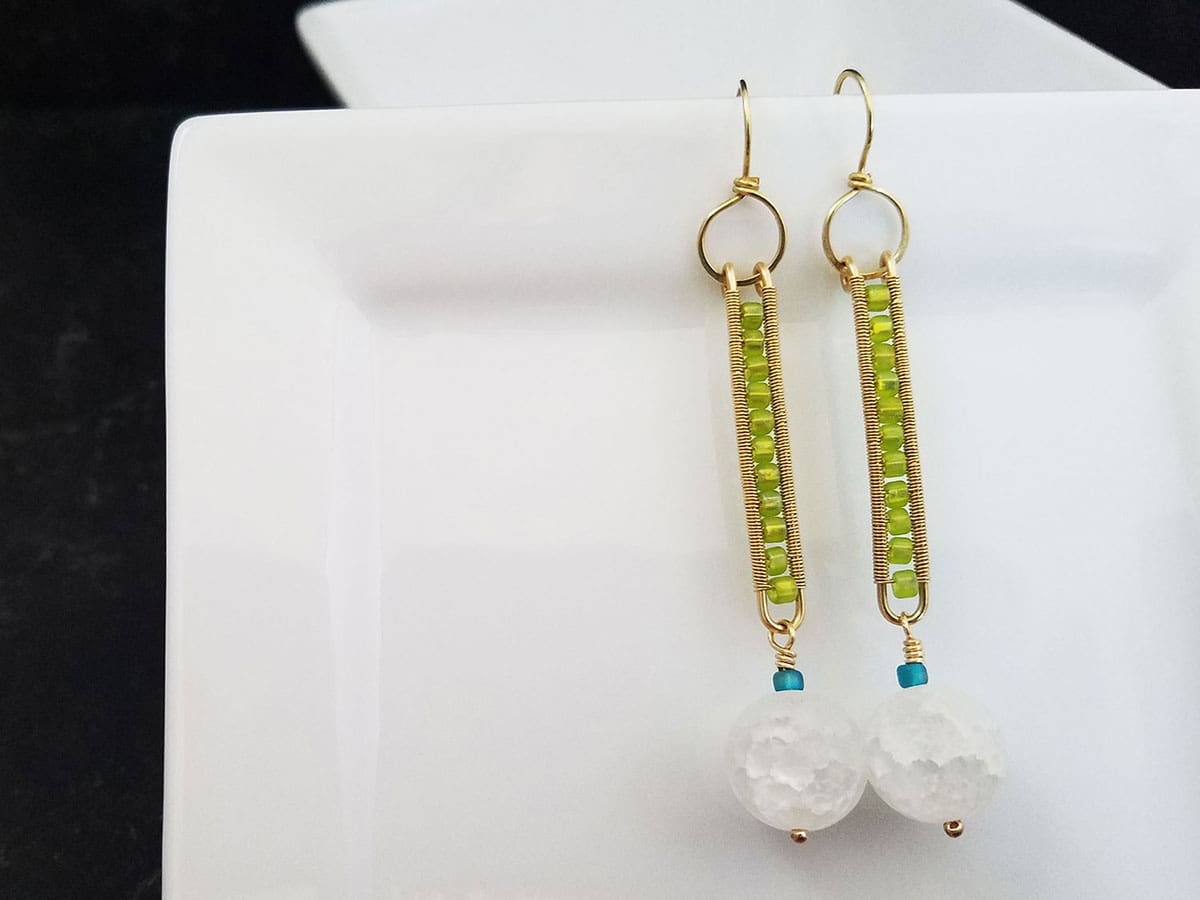

Fantastico ❤️
Fabulous! Very encouraged to try this.
You can do it, Max! Let me know if you run into any problems or have any questions.
Thank you so much for sharing your talents, tips, and tutorials. I just started wire wrapping. It’s very therapeutic for me. And I’m going to try to make this necklace. Your instructions are so well read. I think I can do it. I hope you continue to share with us. Your work is flawless.
I’m so glad you like this pendant. It’s one of my personal favorites. I have at least half a dozen of them in my personal jewelry collection. And I’m sure you can do it. Have fun and don’t hesitate to reach out if you have any questions!